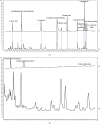Mechanism of Fructus Mume Pills Underlying Their Protective Effects in Rats with Acetic Acid-Inducedulcerative Colitis via the Regulation of Inflammatory Cytokines and the VEGF-PI3K/Akt-eNOS Signaling Pathway
- PMID: 35620404
- PMCID: PMC9129976
- DOI: 10.1155/2022/4621131
Mechanism of Fructus Mume Pills Underlying Their Protective Effects in Rats with Acetic Acid-Inducedulcerative Colitis via the Regulation of Inflammatory Cytokines and the VEGF-PI3K/Akt-eNOS Signaling Pathway
Abstract
Background: Fructus mume pills (FMPs) have been clinically proven to be effective for treating ulcerative colitis (UC). However, the therapeutic and protective mechanisms have not been fully studied.
Aim: We aimed to explore the mechanism of FMPs in an acetic acid (AA)-induced ulcerative colitis rat model.
Methods: The targets, GO terms, and KEGG pathways for the FMPs and UC were screened and constructed using network pharmacology. A possible mechanism was verified in a 4% AA-induced colitis rat model. Colitis activity and state were evaluated using the disease activity index, and colon ulceration and intestinal mucosal damage were determined by histopathological observation through HE, AB-PAS, and Masson pathological staining. The concentrations of TNF-α, IL-6, IL-8, IL-10, MPO, MMP9, CXCR1, eNOS, and VEGF were measured to evaluate vascular permeability effects.
Results: The network pharmacology results showed 108 active compounds, and 139 FMP-related targets were identified. Twenty-nine targets were identified for FMPs against UC, which included MMP9, MMP3, ESR1, PTGS1, PPARA, MPO, and NOS2. A total of 1,536 GO terms and 41 pathways were associated with FMP treatment of UC. The pharmacological evaluation showed that FMPs attenuated inflammation in AA-induced colitis by reducing the serum concentrations of TNF-α, IL-6, IL-8, and IL-10 and the colonic concentrations of MPO, MMP9, and CXCR1. FMPs ameliorated hyperpermeability by reducing the colonic VEGF and eNOS concentrations. FMPs also significantly decreased the VEGFA, VEGFR2, Src, and eNOS protein expressions in colon tissue through the VEGF-PI3K/Akt-eNOS signaling pathway.
Conclusion: These results suggest that FMPs control UC inflammation by regulating inflammatory cytokine concentrations. FMPs alleviate AA-induced UC by regulating microvascular permeability through the VEGF-PI3K/Akt-eNOS signaling pathway.
Copyright © 2022 Zongying Xu et al.
Conflict of interest statement
The authors declare no competing interests.
Figures









References
-
- Zhang S. S., Shen H., Zhen K., et al. Ulcerative colitis diagnosis and treatment experts consensus(2017) Chinese journal of traditional Chinese medicine . 2017;32(08):3585–3589. (in Chinese)
-
- van der Valk M. E., Mangen M.-J. J., Severs M., et al. Comparison of costs and quality of life in ulcerative colitis patients with an ileal pouch-anal anastomosis, ileostomy and anti-tnfα therapy. Journal of Crohn’s and Colitis . 2015 Nov;9(11):1016–1023. doi: 10.1093/ecco-jcc/jjv134. - DOI - PubMed
LinkOut - more resources
Full Text Sources
Research Materials
Miscellaneous

